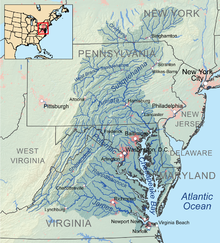Pocahontas (ship, 1829)
|
||||||||||||||
|
||||||||||||||
|
||||||||||||||
The Pocahontas was a passenger steamship which was used from 1829 to 1840 in regular service on the routes between Baltimore , Norfolk and Richmond and was destroyed in the Civil War.
Shipbuilding
In 1828 the Maryland & Virginia Steamboat Company was founded to operate the passenger transport on the Chesapeake Bay between Baltimore and Norfolk and the rivers that flow into the bay. From the estate of Benjamin Ferguson, the company acquired the two steamers Virginia and Norfolk, built in 1817, and ordered two more steamers in parallel. The Columbus and the Pocahontas , built by the Baltimore-based Beecham & Gardiner shipyard, were delivered the following year and used in regular service together with the company's other two paddle steamers.
The smaller Pocahontas was 42 meters long, had a gross tonnage of 428 and, as a contemporary report shows, was comfortably equipped for an inland steamship:
- “It's a first class ship in every way; Exclusively designed to transport passengers, their extremely perfect furnishings combine elegance and comfort [...]. The main cabin or the dining room is below deck - a spacious, bright, well-ventilated, nicely decorated and furnished apartment with 32 comfortable cabins. Hundreds of people can be cared for here at the blackboard […]. The front cabin contains 20 sleeping cabins, a bar and a dressing room. A cabin reserved exclusively for women, an elegant apartment, is located on the main deck; Richly furnished and decorated, it contains 20 sleeping cabins and two salons. An overdeck, the height of which allows the main deck and the cabins below, an abundance of light and an unimpeded air supply, extends over the entire length and breadth of the ship and offers a safe, charming promenade of the greatest possible dimensions. "
Sale and Destruction
In 1840 the Baltimore Steam Packet Company took over the ship for $ 8,000 . Five years later, the company sold the Pocahontas to the Powhatan Steamboat Company , which used it on the James River.
With the outbreak of the American Civil War in 1861, this line ceased operations and the ship was chartered by the Union Army. On a trip to Roanoke Island with 80 people on board (crew and soldiers) it struck north of Cape Hatteras on January 18, 1862 and broke into three parts in a storm, killing 90 horses.
literature
- Brown, Alexander Crosby: Steam Packets on the Chesapeake. A History of the Old Bay Line Since 1840 . 1961; ISBN 0-8703-3111-6
- Rehbein, Elfriede: On water and on land. The history of transport from its beginnings to the end of the 19th century . Leipzig 1984
Web links
Individual evidence
- ^ Baltimore and Norfolk boats. From the early days to the present. Carolina Work Boats Project, accessed January 3, 2016 .
- ↑ Quoted from Rehbein 1984, p. 215, based on the original quotation in Brown 1961, p. 16. This originally appeared on September 14, 1829 in the Norfolk and Portsmouth Herald .
